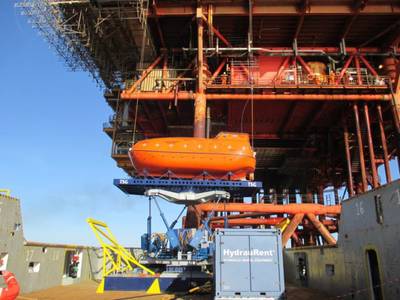Motion Compensation Aids Offshore Lifeboat Lift
In a refurbishment program to upgrade lifeboats on offshore platforms, Ampelmann completed a second successful reinstallation using its full motion compensation technology. The eight-metric-ton lifeboat was kept completely stationary above the vessel deck, to allow lifting by the platform’s davit cranes.
Traditionally, refurbished lifeboats are reinstalled on the offshore structure in the following manner: a platform supply vessel takes the lifeboat offshore, where it is lifted from the deck to the sea. Crew then enter the lifeboat, sail it under the offshore structure and attach the davit fall wires. The crew is removed from the lifeboat before lifting can commence. This operation is generally limited to calm weather and wave conditions, and requires challenging manhandling actions by the crew.
In late December 2013, Talisman Sinopec Energy UK contracted Ampelmann to assist in making this operation less weather-dependent and to reduce risk to the offshore crew. Together with partner TSG Marine, Ampelmann developed an installation method that was deployed in March for a first successful lift, followed by a second installation at the end of July.
The Ampelmann hexapod is capable of compensating actual heave motions of the vessel up to 2.5 meters which increases the workability significantly, even in adverse weather conditions. Where normally an Ampelmann system is topped with a gangway to transfer people, for this operation TSG Marine designed a cradle to support the lifeboat. The vessel was maneuvered beneath the davit crane with the fall wires lowered to the deck of the ship and safely connected to the lifting ropes of the lifeboat. Ampelmann then performed its full motion compensation while the ropes were pulled in. Thanks to this unique process, the installation of lifeboats is not tied to the summer period, but can also take place during the winter months. The Ampelmann ‘plug & play’ motion compensated gangway systems can be installed on any vessel with sufficient deck space in about 8 hours.
Jan van der Tempel, Ampelmann Founder and CEO, said, “As the global leader in motion compensation systems, we are now working on the world’s largest motion compensating crane: the CTS (Cargo Transfer System). We look forward to providing our technology, experience and knowledge for many more hoisting projects in the future.”
ampelmann.nl











